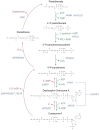The Pathophysiological Role of CoA
- PMID: 33260564
- PMCID: PMC7731229
- DOI: 10.3390/ijms21239057
The Pathophysiological Role of CoA
Abstract
The importance of coenzyme A (CoA) as a carrier of acyl residues in cell metabolism is well understood. Coenzyme A participates in more than 100 different catabolic and anabolic reactions, including those involved in the metabolism of lipids, carbohydrates, proteins, ethanol, bile acids, and xenobiotics. However, much less is known about the importance of the concentration of this cofactor in various cell compartments and the role of altered CoA concentration in various pathologies. Despite continuous research on these issues, the molecular mechanisms in the regulation of the intracellular level of CoA under pathological conditions are still not well understood. This review summarizes the current knowledge of (a) CoA subcellular concentrations; (b) the roles of CoA synthesis and degradation processes; and (c) protein modification by reversible CoA binding to proteins (CoAlation). Particular attention is paid to (a) the roles of changes in the level of CoA under pathological conditions, such as in neurodegenerative diseases, cancer, myopathies, and infectious diseases; and (b) the beneficial effect of CoA and pantethine (which like CoA is finally converted to Pan and cysteamine), used at pharmacological doses for the treatment of hyperlipidemia.
Keywords: CoA; CoAlation; cancer; coenzyme A; neurodegenerative diseases.
Conflict of interest statement
The authors declare no conflict of interest. The funders had no role in the design of the study; in the collection, analyses, or interpretation of data; in the writing of the manuscript, or in the decision to publish the results.
Figures




References
-
- Lykstad J., Sharma S. Biochemistry, Water Soluble Vitamins. StatPearls Publishing; Treasure Island, FL, USA: 2019. - PubMed
-
- Miller J.W., Rucker R.B. Pantothenic Acid. Present Knowledge in Nutrition. 10th ed. Wiley-Blackwell; Hoboken, NJ, USA: 2012. pp. 375–390.
-
- Patassini S., Begley P., Xu J., Church S.J., Kureishy N., Reid S.J., Waldvogel H.J., Faull R.L.M., Snell R.G., Unwin R.D., et al. Cerebral Vitamin B5 (D-Pantothenic Acid) Deficiency as a Potential Cause of Metabolic Perturbation and Neurodegeneration in Huntington’s Disease. Metabolites. 2019;9:113. doi: 10.3390/metabo9060113. - DOI - PMC - PubMed
Publication types
MeSH terms
Substances
Grants and funding
LinkOut - more resources
Full Text Sources

